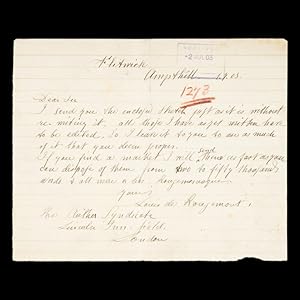GRIN, HENRI LOUIS (2 Ergebnisse)
Produktart
- Alle Produktarten
- Bücher (2)
- Magazine & Zeitschriften
- Comics
- Noten
- Kunst, Grafik & Poster
- Fotografien
- Karten
-
Manuskripte &
Papierantiquitäten
Zustand
- Alle
- Neu
- Antiquarisch/Gebraucht
Einband
Weitere Eigenschaften
- Erstausgabe
- Signiert
- Schutzumschlag
- Angebotsfoto (1)
Land des Verkäufers
Verkäuferbewertung
-
Incroyables aventures de Louis de Rougemont. Ouvrage illustré de 112 gravures dessinées par A. Pearse.
Verlag: Paris, Hachette et Cie., 1901
Anbieter: Antiquariat im Hufelandhaus GmbH vormals Lange & Springer, Berlin, Deutschland
112 Stiche, 248 S. Original-Leinenband mit reicher Schmuckprägung (Kapitale bestoßen und leicht eingerissen, Rückdeckel leicht fleckig). Umlaufender Goldschnitt. Vorsatz und Vortitel mit handschriftlichem Vermerk, fliegendes Vorsatzblatt mit ausgeschnittener Fehlstelle entlang der Oberkante. Bindung gelockert. Rückdeckel zum Teil vom Buchblock gelöst. Sonst innen in schöner Erhaltung. Sprache: Französisch.
-
Manuscript in ink on ruled paper, 160 x 200 mm; headed 'Flitwick, Ampthill, 1.7.03', the letter is addressed to The Author Syndicate, Lincoln Inn Field, London, and is signed at the foot 'Yours, Louis de Rougemont'; wet stamped 'Received 2 Jul 03', and with a correspondence number in red crayon; original vertical fold, clean and legible. An interesting piece of business correspondence in the hand of the extraordinary Louis de Rougemont (1847-1921), 'The Greatest Liar on Earth', which illuminates his entrepreneurial modus operandi. De Rougemont writes to a London editor: 'Dear Sir, I send you the enclosed sketch just as it is without re-writing it. All those I have as yet written have to be edited, so I leave it to you to use as much of it that you deem proper. If you find a market I will send them as fast as you can dispose of them from two to fifty thousand words & all more or less Rougmonesque.' From the ADB: 'Louis de Rougemont (1847-1921), hoaxer, was born Henri Louis Grin on 12 November 1847 at Gressy, Vaud canton, Switzerland, son of Antoine Samuel Emanuel Grin, farmer, and his wife Jeanne, née Perret. Educated at a local primary school, he moved with his family to Yverdon, where he worked in his father's wagon business. At about 16 he became a footman to the actress Fanny Kemble, touring extensively and learning fluent English. In 1870-74 he was a valet in London, and in 1875 came to Australia as a butler with the new governor of Western Australia, Sir William Robinson; to Lady Robinson he was insolent and ambitious, and left after five months. In June Grin became master and owner of the pearling cutter Ada, which was posted missing in February 1877 some months before it was found wrecked near Cooktown, Queensland; Grin claimed to have sailed the 3000 miles (4828 km) from Fremantle and to have been the sole survivor of an attack by Aboriginals at Lacrosse Island. By May 1880 he had arrived in Sydney. He worked as a dishwasher, waiter and seller of real estate and mining shares, but mainly as a photographer. On 3 April 1882, as Henri Louis Grien, he married Eliza Jane Ravenscroft at the Presbyterian manse, Newtown; they had seven children. He was also known as 'Green' and 'Grein'. Early in 1897 Grin deserted Eliza and fled Sydney taking a copy of the diary of a bushman, Harry Stockdale. He surfaced in New Zealand as a spiritualist and then worked his way to England, arriving in March 1898. As Louis de Rougemont he called on (Sir) J. Henniker Heaton, who gave him a letter of introduction to the editor of the new Wide World Magazine. From August 1898 to May 1899 it serialized 'The adventures of Louis de Rougemont', which focused fancifully on the astounding experiences he had had while allegedly spending thirty odd years as a castaway among the Aboriginals of North-West and Central Australia. The articles were republished as The Adventures of Louis de Rougemont, as Told by Himself (1899); they were fluently and cleverly written, but essentially the plausible concoction of a colonial Munchausen. In the furore that erupted de Rougemont was supported by his publishers and by John Moresby; he lectured in September 1898 to the geography and anthropology sections of the Bristol meeting of the British Association for the Advancement of Science. But his claims were doubted by Louis Becke and strongly disputed by D. W. Carnegie in the London Daily Chronicle. Assisted by revelations in the Sydney Evening News and Daily Telegraph, the London paper established that the hoaxer had been identified by Eliza from a copy of Wide World; the Chronicle's articles, republished as Grien on Rougemont; Or, the Story of a Modern Robinson Crusoe (London, 1898), provide the information on Grin's life from which most subsequent accounts derived. At the time of the controversy de Rougemont was described as tall and lightly built with a thin, seamed face, full eyes, heavy lids, bristly hair, pointed beard and cultured voice; as caricatured by Phil May he looked remarkably like May's Bulletin companion of the 1880s, Livingston Hopkins. In 1899 he was a music-hall attraction in South Africa as 'The greatest liar on earth'; on a similar tour of Australia in 1901 he was booed from the stage. As 'Louis Redman', handyman, he died in London on 9 June 1921, and was buried in St Mary's Roman Catholic cemetary, Kensal Green. He was survived by his second wife Thirza Ann Wolf, née Ellis, divorcee, whom, as Louis de Rougemont, he had married on 28 July 1915. She had his death certificate amended in 1929.'.



